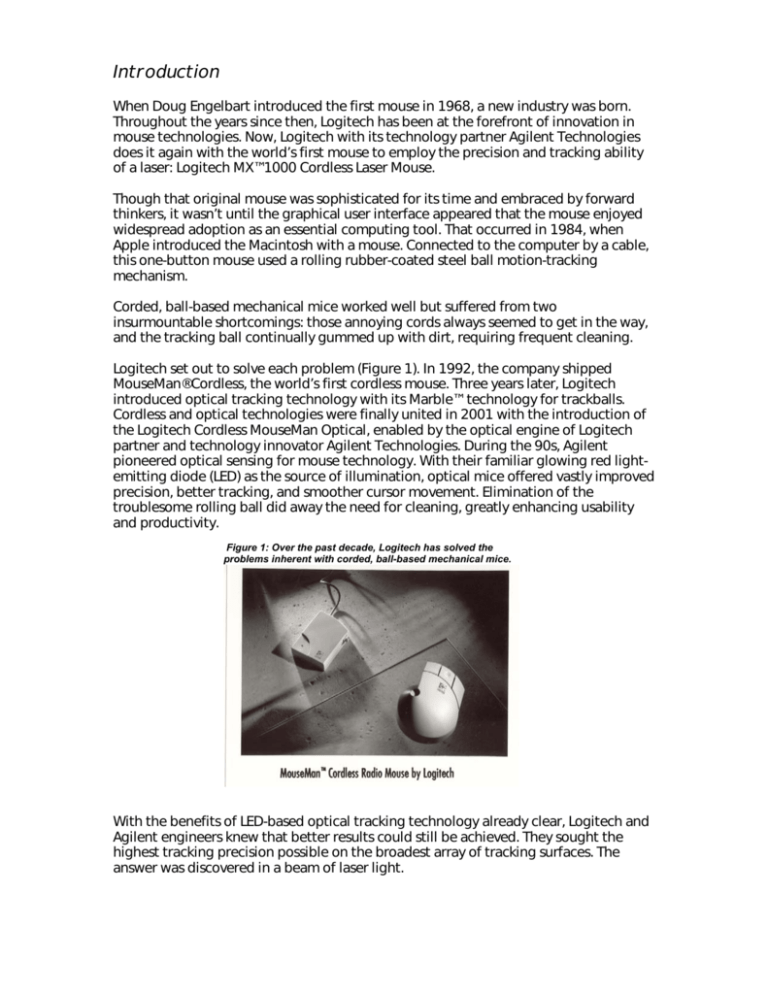
Introduction
When Doug Engelbart introduced the first mouse in 1968, a new industry was born.
Throughout the years since then, Logitech has been at the forefront of innovation in
mouse technologies. Now, Logitech with its technology partner Agilent Technologies
does it again with the world’s first mouse to employ the precision and tracking ability
of a laser: Logitech MX™1000 Cordless Laser Mouse.
Though that original mouse was sophisticated for its time and embraced by forward
thinkers, it wasn’t until the graphical user interface appeared that the mouse enjoyed
widespread adoption as an essential computing tool. That occurred in 1984, when
Apple introduced the Macintosh with a mouse. Connected to the computer by a cable,
this one-button mouse used a rolling rubber-coated steel ball motion-tracking
mechanism.
Corded, ball-based mechanical mice worked well but suffered from two
insurmountable shortcomings: those annoying cords always seemed to get in the way,
and the tracking ball continually gummed up with dirt, requiring frequent cleaning.
Logitech set out to solve each problem (Figure 1). In 1992, the company shipped
MouseMan® Cordless, the world’s first cordless mouse. Three years later, Logitech
introduced optical tracking technology with its Marble™ technology for trackballs.
Cordless and optical technologies were finally united in 2001 with the introduction of
the Logitech Cordless MouseMan Optical, enabled by the optical engine of Logitech
partner and technology innovator Agilent Technologies. During the 90s, Agilent
pioneered optical sensing for mouse technology. With their familiar glowing red lightemitting diode (LED) as the source of illumination, optical mice offered vastly improved
precision, better tracking, and smoother cursor movement. Elimination of the
troublesome rolling ball did away the need for cleaning, greatly enhancing usability
and productivity.
Figure 1: Over the past decade, Logitech has solved the
problems inherent with corded, ball-based mechanical mice.
With the benefits of LED-based optical tracking technology already clear, Logitech and
Agilent engineers knew that better results could still be achieved. They sought the
highest tracking precision possible on the broadest array of tracking surfaces. The
answer was discovered in a beam of laser light.
Laser Lights The Way
Now, in 2004, Logitech has taken the first step beyond LED illumination with the
unveiling of a true, next-generation engineering breakthrough: laser illumination and
tracking with the MX1000 Cordless Laser Mouse. For gamers, graphic artists, CAD
engineers, medical technicians, and business users alike, laser technology is an
innovation that delivers a new benchmark in mouse performance.
The culmination of years of research has produced laser technology that delivers
astonishingly precise tracking. Laser tracking responds to the slightest hand movement
with extraordinary accuracy. And it does so on virtually any surface, white or black,
solid or pattern, shiny or matte. Laser illumination tracks flawlessly on the high-gloss
surfaces that LED-based mice simply can’t negotiate. These surfaces include lacquered
tabletops, glazed ceramic tile, untextured plastic, metal surfaces, photo paper,
1
laminate countertops, opaque glass, and more .
Thanks to Logitech and Agilent’s groundbreaking laser mouse technology, virtually any
surface, short of a mirror or pane of clear glass, will do. Mouse pads, those dustcatching relics from the era of rolling-ball mice, are, at last, no longer necessary for
smooth operation.
Motion Tracking
Logitech’s revolutionary laser-powered mice unite the precision of laser illumination
with the proven technology of sensor-based motion tracking in a way never done
before.
To detect movement, all sensor-based mice, regardless of light source, use sensors to
“read” the light beam as it is reflected back into the mouse from the tracking surface
(Figure 2).
Figure 2: An optical mouse works by reading a reflected light beam on
the surface
Each second, Agilent’s optical sensor inside Logitech’s mouse takes more than 6000
snapshot ’fingerprints,’ converts the information to digital format and uses the
changes in ‘fingerprints’ to calculate the mouse’s precise location, speed and direction
of movement (Figure 3). Armed with that knowledge, Logitech’s driver software then
communicates with the computer’s operating system, which moves the cursor image
on the screen.
1
Laser still may not track on mirrored or clear surfaces, such as windowpane glass.
1
Figure 3: Interpreting differences in image fingerprints can be translated to movement of the mouse
Laser illumination reveals structure that an LED simply cannot express. The coherent
nature of laser light creates patterns of high contrast when its light is reflected from a
surface. The pattern appearing on the sensor reveals details on any surface, even glossy
surfaces that would look totally uniform when exposed to the LED incoherent
illumination (Figure 4). The precision image sensors then have no difficulties in
tracking on these patterns and calculating position and movement. This is how laser
2
enables tracking on virtually any surface .
Figure 4: Laser uncovers surface features not detected by LED.
Glossy packaging (LED)
Glossy packaging (Laser)
Whiteboard (LED)
Whiteboard (Laser)
White Tile (LED)
2
White Tile (Laser)
Laser still may not track on mirrored or clear surfaces, such as windowpane glass.
2
Safety First
A quick look around any home reveals lasers improving our lives. From CD and DVD
players to printers and handheld pointers, lasers designed for consumer use offer
enormous benefits and a high degree of safety. But lasers also conjure up images of
destructive ray guns, a staple of science-fiction movies. Fortunately, that’s not the case
with Logitech’s laser mouse technology. Logitech’s laser mice are perfectly safe for
consumers, earning a Class I eye-safe designation. After all, transmitting a beam of
light for the tiny distance required, less than an inch, requires only a minuscule amount
of power.
Conclusion
Though the benefits of optical mice became clear more than a decade ago, now it can
be said that Logitech has fully delivered on the original vision. The technological
breakthrough of Logitech and Agilent’s laser illumination and tracking system makes
available for the first time a cordless experience of world-class precision and silky
smooth operation on even the most problematic surfaces. With MX Laser, Logitech
remains the worldwide leader in input-device innovation.
###
© Copyright 2004 Logitech. All rights reserved. Logitech, the Logitech logo, and other
Logitech marks are owned by Logitech and may be registered.
Logitech.com
3





